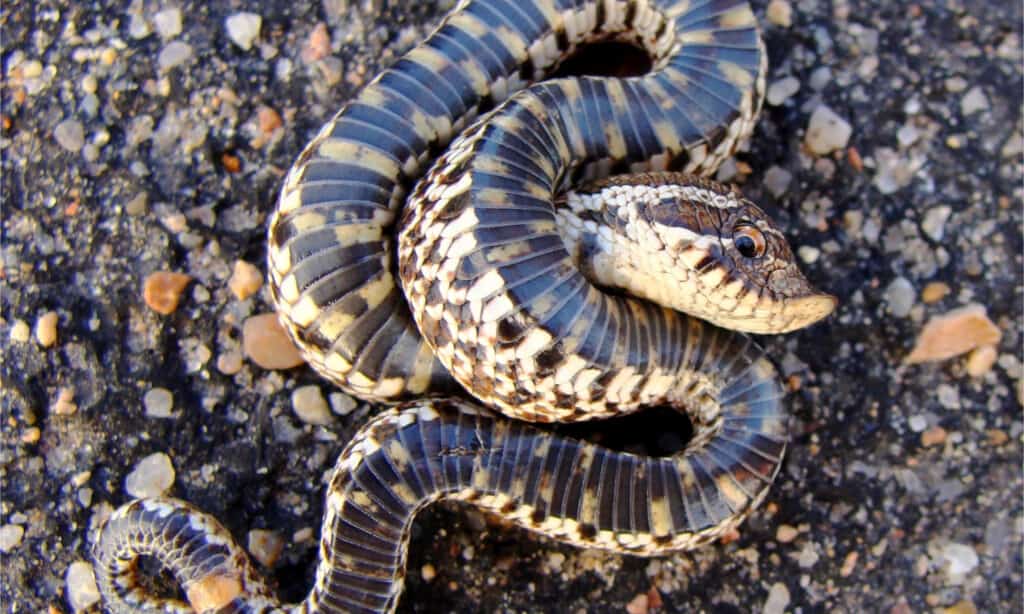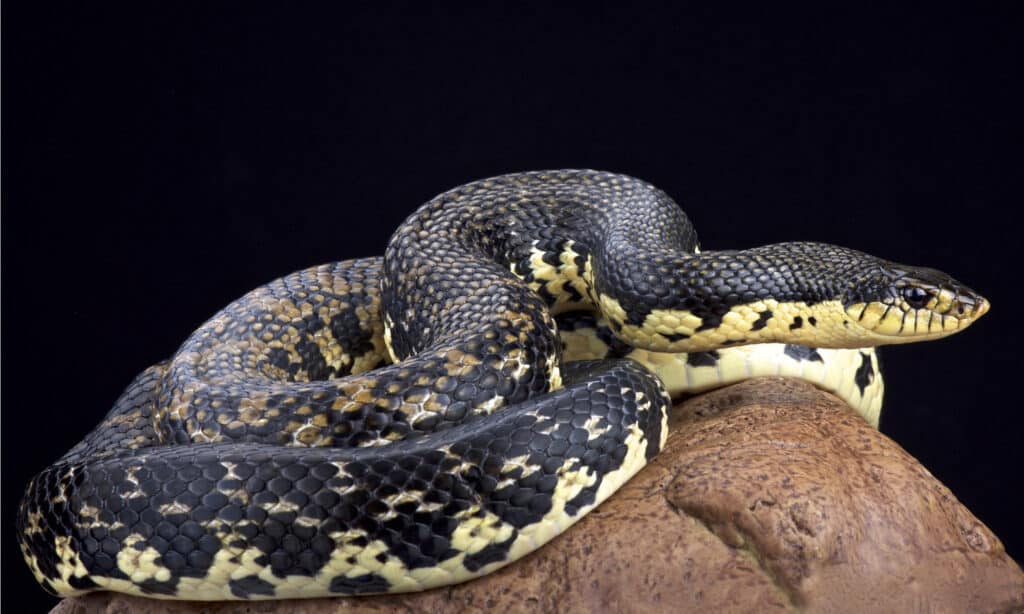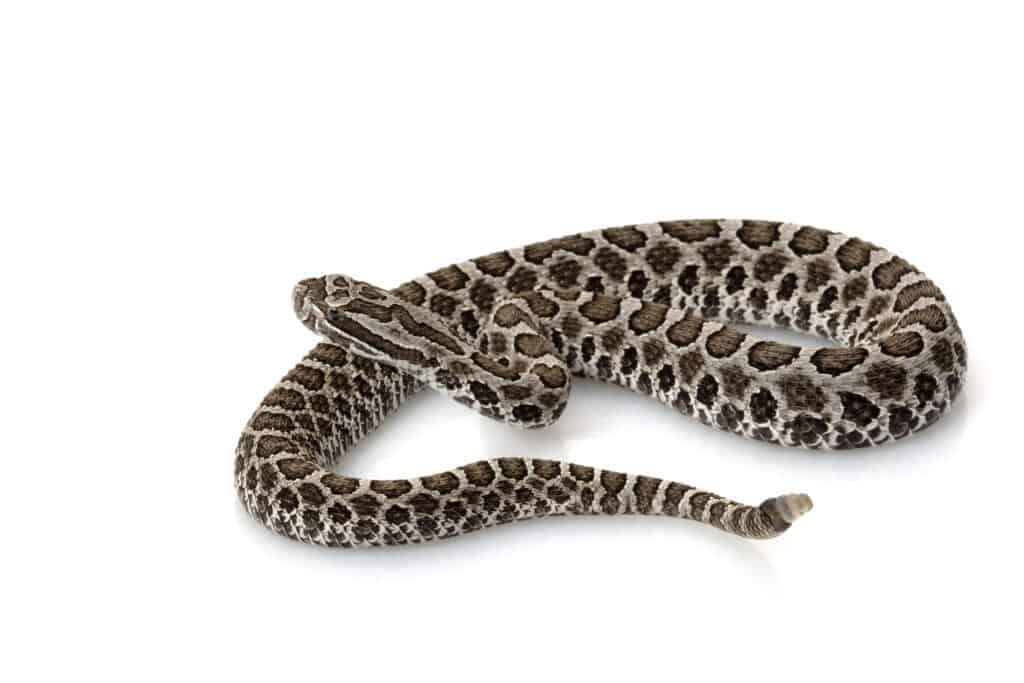Known for their weird noses and dramatic attitudes, hognose snakes are quite the characters. There are five species of hognose snakes found in North America. Generally, hognose snakes aren’t exactly long. However, some species and specimens grow far past average. In this article, you’ll discover the largest hognose snake ever recorded.
Hognose Snakes

Plains hognose snakes roll onto their backs and “play dead” as a defense against predators.
©Matt Jeppson/Shutterstock.com
The hognose snake category is a rather peculiar one. It houses three species (2 colubrids and 1 lamprophiidae) that aren’t entirely related. Only two of these species, the Heterodon and the Lystrophis are native to America. Leioheterodon hognose species are native to Madagascar.
Not all hognose species are known to play dead. This unique trait is found in Heterodon species which are found in North America. North American hognose snakes are dramatic and short creatures. When spotted, they often go limp and play dead. They even let their tongues hang outside their mouths like true actors worthy of Oscars.
Hognose Snake Venom
Although hognose snakes have venomous saliva, it is only fatally dangerous to their prey. Their salivas are known to be mildly toxic but since they do not inject this saliva in any way, the damage they can inflict is minimal. Their saliva mainly helps them when swallowing their prey. They are not known to use their toxic saliva to kill.
How To Identify Hognose Snakes

The most distinctive feature of a hognose snake is its upturned snout.
©iStock.com/chas53
Generally, hognose snakes have sand-brown colors. They also have markings that could be a wide range of colors such as black, white, red, green, orange, and brown. Their markings usually depend on their locality.
However, their most distinctive feature which is probably also the muse behind their name is their upturned snout. They have upturned snout-like noses. This uniting feature between the various species is used to dig up sandy soil. Hognose snakes burrow for various reasons such as hunting. They dig up soil by sweeping it to the side with their noses. Length-wise, the species vary. They generally aren’t long and measure from 2 feet to 4 feet on average.
Largest Hognose Snake Ever Recorded

The largest species of hognose snake is the Madagascar giant hognose snake.
©reptiles4all/Shutterstock.com
There is no official record of a specimen regarded as the largest hognose snake. However, the largest species of hognose snake is the Madagascar giant hognose snake. This species is known to measure up to 6 feet.
Madagascar Giant Hognose (Leioheterodon madagascariensis)
Also known as the Malagasy giant hognose, the Madagascar giant hognose snake is known to measure from 4 to 6 feet. They are classified under the Leioheterodon genus. Apart from their large snouts, they can be identified by their extremely large eyes that seem to want to pop out.
What is the Smallest Species of Hognose Snakes?
The smallest species of hognose snake is the western hognose snake. Western hognose snakes have thick bodies but never grow past 3 feet.
Western Hognose Snake (Heterodon nasicus)
Western hognose snakes are found in southern Canada, the United States, and Mexico. They grow to 2 feet on average but have been known to attain 3 feet. Despite their short sizes, they are rather thick-bodied.
How Long Does It Take for A Hognose to Reach Full Size?
Madagascar hognose snakes will reach full size anywhere from 2 to 4 years. They are known to grow at a rate of 0.8 inches per month for their first 9 months. After this, they slow down and grow at around a quarter of this speed (0.2 inches) per month till they reach 2 to 4 years of age.
How Long Can a Hognose Go Without Eating?
Hognose snakes can go 6 days without eating. Adult hognose snakes only need to be fed once a week. Juveniles eat more frequently at once every 5 days.
Are Hognose Snakes Friendly?
Hognose snakes aren’t friendly. They are shy and prefer to hide. Their sandy coloring means that they can camouflage and blend in to avoid being seen. However, they are far from aggressive and would rather run than attack.
Do Hognose Snakes Make Good Pets?
Hognose snakes make good pets because of their calm natures. In captivity, they often do not mind being handled. Remember not to attempt to catch a hognose snake or any snake in the wild. They hardly bite but can if they feel threatened. They also have musk which they often mix with feces to spray on assailants.
What Do You Feed a Pet Hognose Snake?
Hognose snakes feed on many small mammals, reptiles, and amphibians. If you have a pet hognose snake, you can feed it frogs and toads, as well as mice, lizards, and bugs.
What Should You Do If You Spot A Hognose Snake?
Hognose snakes do all they can to escape when they are spotted. If you spot a hognose snake, there is no reason to fear. Gently exit and leave it alone. If it is your home, contact pest controls services. Remember that snakes are an important part of the ecosystem and shouldn’t be killed.
What Should You Do If You Get Bitten by A Hognose Snake?
Hognose snakes hardly ever bite humans. However, it is a possibility so it will not hurt to be prepared. If you get bitten by a hognose snake, treat it as an emergency. Remember that their toxic saliva can get into cuts made by their teeth. Treat any snakebite as an emergency and contact the appropriate authorities.
Where Are Hognose Snakes Found in America?
Jeffrey C. Beane, a researcher at the North Carolina State Museum of Natural Sciences, describes the southern hognose snake (Heterodon simus) as a “poorly known and declining species” located in the southeastern U.S. Hognose snakes are found from southern Florida to central New England, spanning across the eastern half of the US. They are also found in the Great Lakes region, South Carolina, and Georgia.
Other Record-Breaking Snakes

©fivespots/Shutterstock.com
If you’re curious about the Largest Massasauga Snake Ever Recorded, then you’ve come to the right place! This snake, which broke records due to its impressive size and weight, is certainly a fascinating creature. To answer your first question – yes, we can tell you all about it.
The Largest Massasauga Snake Ever Recorded was an absolute giant in every sense of the word. It measured a whopping 49 inches long and weighed over 4 pounds! These measurements make it one of the largest snakes ever recorded in North America.
As for where this record-breaking snake was found – it was discovered in Michigan’s Upper Peninsula by two biologists who were conducting research on reptile populations in the area. They stumbled upon this massive snake while walking along a rocky outcrop near a riverbank.
Now, let’s talk about how big these snakes normally are. The Massasauga snake is actually quite small compared to other species of snakes found around the world. On average, they grow to be between 20 and 30 inches long and weigh only a few ounces. However, there have been reports of larger specimens measuring up to 36 inches.
The photo featured at the top of this post is © reptiles4all/Shutterstock.com
Discover the "Monster" Snake 5X Bigger than an Anaconda
Every day A-Z Animals sends out some of the most incredible facts in the world from our free newsletter. Want to discover the 10 most beautiful snakes in the world, a "snake island" where you're never more than 3 feet from danger, or a "monster" snake 5X larger than an anaconda? Then sign up right now and you'll start receiving our daily newsletter absolutely free.
Thank you for reading! Have some feedback for us? Contact the AZ Animals editorial team.






